“Maserati, The Family Silver,” is an extremely important book; over 15 years in the making, it is the most comprehensive book on Maserati ever written and it may well be the last such book in English. It is the winner of the 2016 Guild of Motoring Writers Mercedes/Montagu of Beaulieu Trophy. (Photos in this review courtesy the Publisher.)
Looking for comparisons
I look on my bookshelves to see what we have on other car manufacturers which are similar to Nigel Trow’s 800 page two-volume epic on the history of Maserati: I see very little to compare.
I look on the Internet; surely there is a comparable set of volumes about Ferrari, one of the most written about cars ever. I find Bruno Alfieri’s three-volume set, “Ferrari Opera Omni 1946-2002,” but that ends at 2002 and is more of a compendium of models and stats rather than an in-depth history. Ferrari history, though actually much shorter than Maserati’s, is scattered into dozens of works on individual models and even serial numbers.
Alfa has Fusi (and company) and Peter Hull – but nothing like Trow’s work. As is the case with all manufacturers, there are many short histories available; Trow himself had written one of the best Lancia histories, “Lancia, The Shield and Flag” (1980) but at only 272 pages it is a minor volume compared to his latest work. “Mercedes-Benz Quicksilver Century”, Karl Ludvigsen’s 617 page history comes close, but closes in 1995 and ditto his Porsche history, “Excellence Was Expected-The Complete History of the Sports and Racing Cars” but covers the marque to only 1977. Trow’s work also surpasses the existing Maserati history by Orsini and Zagari by date (Orsini published in 1980) page number and depth.
Pursuing this theme, we wondered if two outstanding books – both on Ford – were made into one: Allan Nevins’ “Ford, The Times, The Man, The Company” which still sets the standard for an automotive company history, and Leo Levine’s “Ford: The Dust and the Glory.” To combine the history of the family, the company, the cars and the races in one epic tome with this kind of depth and scope would be the ultimate marque history book. Trow goes far down that path with Maserati, further perhaps than anyone else.
No doubt there is something out there we have overlooked, but if not unique, “Maserati, The Family Silver” is one of the most well-researched, in-depth look at any marque so far. Bear in mind that this is huge, 11 x 9 two-volume set numbering over 800 pages set in 11 point font with no distractions, headers or subheads. It is classically dense, a reader’s book, no nonsense and almost every paragraph contains seriously deep factoids.
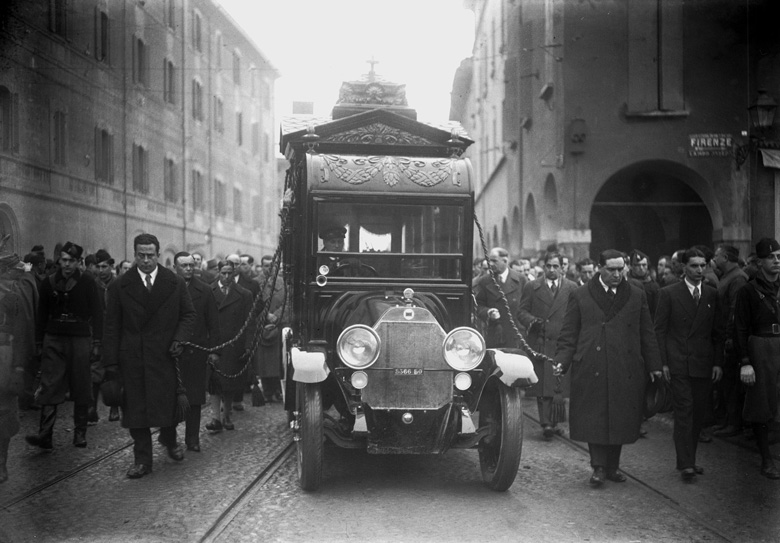
Alfieri Maserati’s funeral in 1932. Though Alfieri was the lead designer, driver, fund raiser, and guiding light of the new Maserati company, after his tragic death the brothers forged ahead regardless.
What makes this different?
Geoffrey Goldberg, author of “Lancia and De Virgilio, At the Center” and friend of Trow’s, explains the scope, which puts the main subject into a broader social context. “Rather than comparing it to average marque histories, ‘The Family Silver’ is best seen against more general period histories, such as Anthony Blight’s ‘The French Sports Car Revolution.’ That book’s central theme was the evolution of the sports car from a voiturette to a totally different, substantially engineered product throughout the 1930s, a period deeply affected by growing political interests. Such histories operate outside of the normal recording of a marque’s accomplishments, and show how auto makers evolve within larger cultural shifts.”
Maserati = Racing
If Maserati equals racing, one is hard put to be critical of the text, which largely deals with Maserati’s successes and failures on the track. Take Prichard’s “Maserati, A History,” throw in a lifetime of knowledge and research as well as a superb social context, and you have the history of the Maserati company until 1965. Until the advent of the productionized 3500GT, Maserati raced cars and their history must be told in terms of races entered, won or lost. As exciting as racing can be in reality, a good bit is lost in translation to the written page and therefore it can often be tedious, but Trow weaves in a great deal about the cars themselves and the family as well, and saves us from Prichard’s more typical race result monologue.
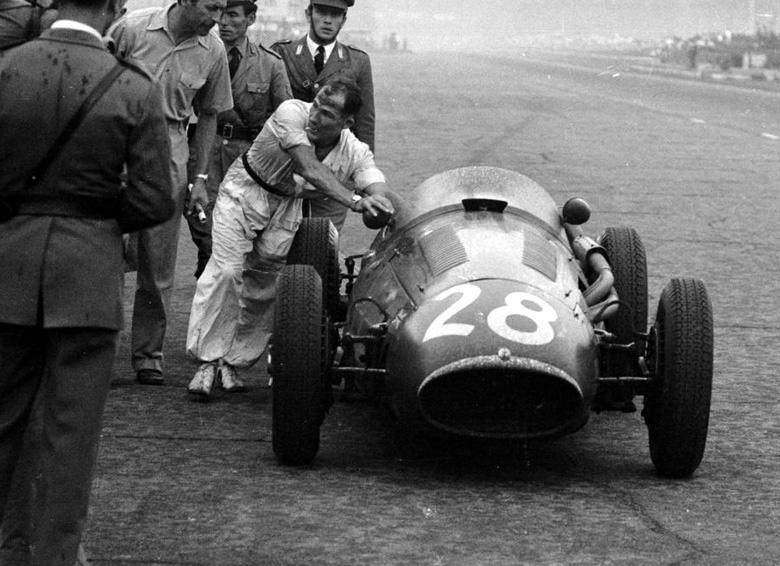
Maseratis were not known for their reliability. Moss pushes his 250F after an oil line broke while leading the 1954 Italian Grand Prix.
By Volume
Goldberg described the first volume as providing “…a detailed explanation of the evolution of the young Maserati brothers, fabricators in their hearts, from very rough and crude beginnings through to racing efforts in the 1930s, as they continued to develop a more finished product and became among the best in the world. Each year is given a single chapter; and in a detailed recounting, almost each car is provided with particulars and construction, evolving race by race.”
The second volume is devoted to the years 1945 to 2014 (the book was published in 2016) and continues in the same vein minus the Maserati brothers themselves, who left in 1947 to form OSCA. But after 1965 when racing activities ceased, Trow focuses on the problems with successive owners, until Fiat finally came to the rescue by ironically producing Ferrari-engined Maseratis for the road saving the marque but destroying the magic. Trow writes of the Orsi family as he does the Maseratis. The business under the Orsis is fully recounted including the wartime construction of electric vehicles and the labor problems that plagued the company after the war.
One might be put off by the lack of photos—only roughly 200 per 800 pages. The photos published are rare and excellent, and it was not the author’s intent to make this a standard picture book coffee table item. There are plenty of those about and this, thankfully and definitely does not fall into that category. Goldberg agrees, “This two volume history is no coffee table book. It remains largely as a written document, unusual in our present age of rapid picture consumption. This is history told in a classical way, with elegant writing, as only the best British writers can do. To read ‘The Family Silver’ is to remember how people used to write, with the text carefully crafted in pursuit of the poetic.”
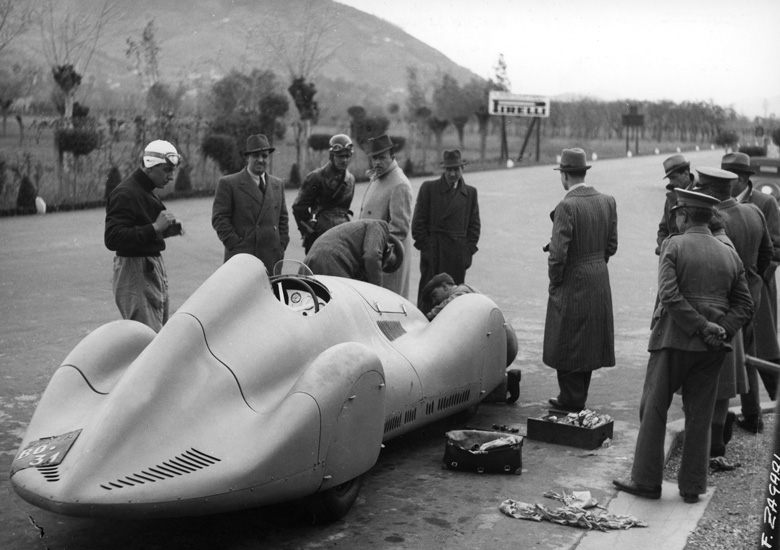
The 4CL Streamliner was built to compete in the 1939 Grand Prix of Tripoli. Here Luigi Villoresi tests the car on the Autostrada in April, 1939.
However, it does help to have a book such as the Crump/Box’s “Maserati, Sports, Racing and GT Cars” on hand when reading Trow. There is a complete list of technical specs for each model in the appendix as well as a list of Maserati race victories including class wins. Also included is a decent index and bibliography. For other sources, Trow uses factory archives, documents, and discussions with Ermanno Cozza, the Maserati archivist, Adolpho Orsi, Alfieri Maserati, and every major English and Italian automobile magazine from the turn of the 20th century.
What is not included, and our main concern with the book, is the lack of documentation of sources. While we don’t doubt the veracity of any of the statements or quotes, it would be nice to know the source of the story. For future historians, this is even more critical if any work is to be taken seriously. That said, few other books in our library are properly documented either, including Prichard, Box, and others.
Family First
Looking at the history of Maserati from the past forward, one might see the Maserati family as the originators, creators, designers, spiritual founders, and the essence of the marque, followed by the Orsi takeover in 1937, from which point it was virtually another company entirely. For a historian, there is a fork in the road here; follow either the Orsis or the Maseratis, and the one that that Trow chose was to follow the trail of the Orsis. There is nothing wrong with this and it is entirely logical, and from a sales point of view, wiser. However…
When researching OSCA for an article in “Autombile Quarterly” back in the 1990s, clearly there was a lot more to the story of OSCA than just the cars, and it was the amazing Maserati brothers. At the time there was precious little information on the family; brief bios, same sources, nothing in depth. So I created a list of 30 questions to be put to Alfieri Maserati, Ernesto’s son, which addressed the family specifically, such as “Did your father often argue with his brothers” and “What was life like growing up as a Maserati in Bologna and Modena?” However the article was cancelled and the questions remained just questions. But would Trow’s new book answer them for me?
I consider that roughly 20 of the 30 questions were answered to a satisfactory degree and five or so were not relevant, so overall, Nigel pretty well covered the bases. They are all interwoven into the text and span the volumes, since organization of chapters is by year vs subject or topic, such as “The Maseratis at Home”.
And given the brothers’ most famous virtue – silence, that’s pretty good. The first thing one learns about the Maserati brothers is that they were very private; the word ‘taciturn’ appears time and time again in descriptions of the brothers.
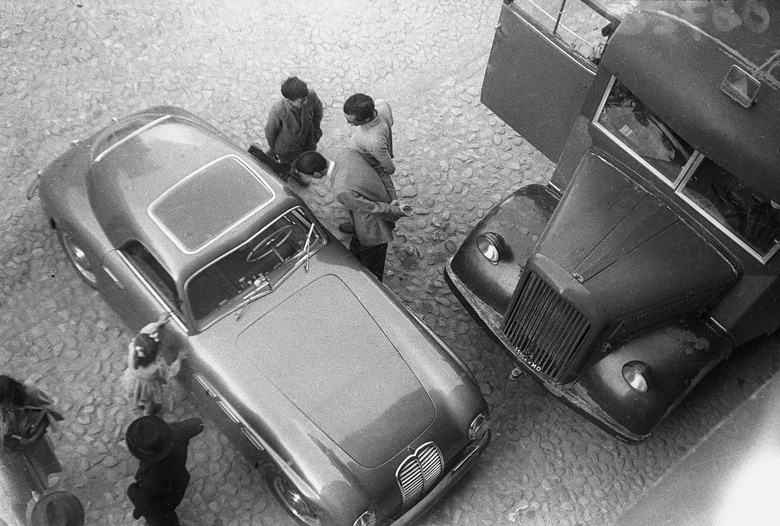
A new era began with the departure of the Maserati brothers from the Orsi concern, heralded by the introduction of the Pininfarina 1500 coupe.
Since Trow decided to follow the Orsis instead of the Maseratis after the split, there is a need for another volume that would augment the excellent “Osca – La Rivincita Dei Maserati” (Revenge of Maserati) by Orsini and Zagari, which provides photos and models but not much in the way of detailed factory or family history. Anyone up for the task?
Five (Carlo, Alfieri, Bindo, Ernesto and Ettore) of the seven Maserati brothers were involved in cars and racing from the dawn of the automotive age to the end of the postwar European miracle, making a life and their living by building successful race cars. Unlike most, it was a family affair, not an individual effort ala Chapman or Gordini or Kurtis or Broadley. As such, it is a huge and important story almost unheard of in the annals of automotive history. Trow has accomplished much. One more book to go, Nigel!
Maserati, the Family Silver is available in three editions. The Tifosi edition printed on heavyweight silk art paper, buckram bound with dust jackets and presented in a bespoke buckram slipcase costs £195 while the Collectors’ edition is limited to 101 numbered copies worldwide, hand-bound in leather and presented in a bespoke, cloth-bound slipcase and is priced at £595. It is also the winner of the 2016 Guild of Motoring Writers Mercedes/Montagu of Beaulieu Trophy. ORDER HERE

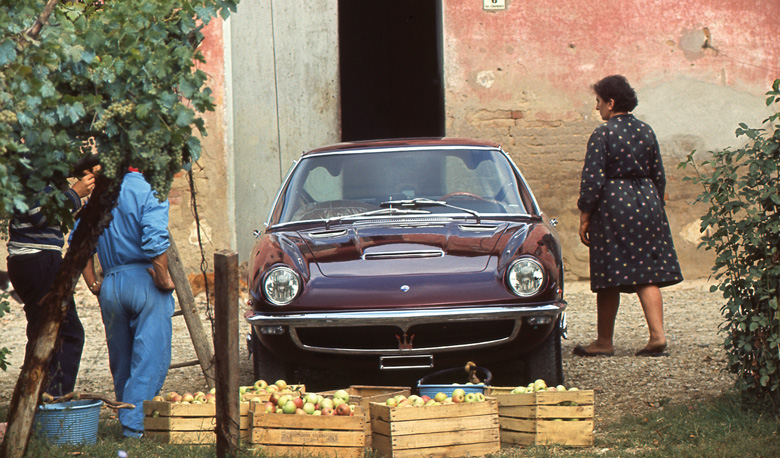

Whoops!
Ludvigsen’s three-volume current history of Porsche is complete up to 2008.
Sorry Karl! Some old info on the Internet…
Pete
Pete
Liked your review and very much agree. Interesting about naming sources….I tend to agree though when I have done it the response has occasionally been “pedantic”! The author’s main source is the amount and depth of his own hunting and questioning.
Ed